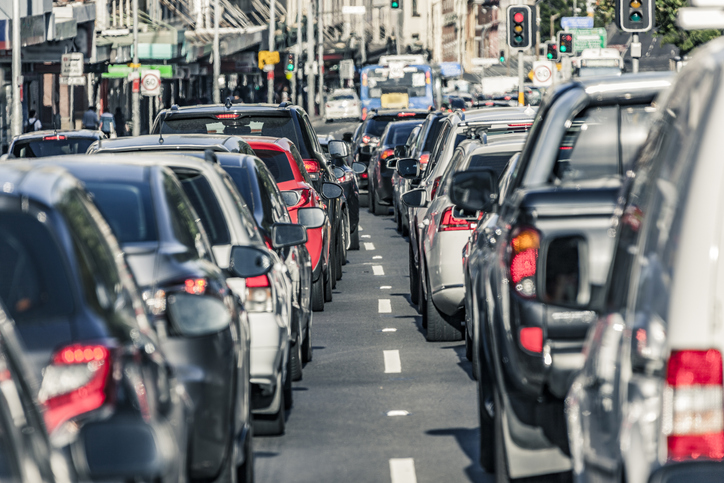A massive infrastructure investment is needed over the next decade for Australian cities to keep pace with unprecedented population growth, a new audit of infrastructure spending warns.
Infrastructure in Australia’s four largest cities is failing to keep pace with rapid population growth, particularly on the urban fringe, an audit from Infrastructure Australia, released on Tuesday, found.

The audit, which surveys the nation’s infrastructure challenges and opportunities over the next 15 years, found Australia’s big cities are feeling the pinch of population growth, with crowding on public transport and congestion on the roads set to grow from $18.9 billion to $38.8 billion in 2031.
A material increase in the level of investment across the board has boosted the performance of infrastructure but more must be done to maintain quality of life as Australia braces for 23.7 per cent population growth by 2034, it says.
While progress has been made to close infrastructure gaps with $123 billion of work commencing since 2015, changing demands and a growing maintenance backlog mean that more investment is needed to meet the growing task.
In capital cities, the dominance of infill development will require investment in high capacity public transport, enhancements to energy and water infrastructure, improved shared spaces and a renewal of inner city health and education services, the report suggests.
Infrastructure Australia Chair Julieanne Alroe said the report signals the need for substantial investment in infrastructure.
“Rather than a short-term boom, the historic level of activity we are seeing in the sector must, and is likely, to continue for the next 15 years and potentially beyond. This must be the new normal if we are to meet the challenges and opportunities ahead,” Ms Alroe said.
“Changing and growing demand, and a mounting maintenance backlog is putting unprecedented pressure on the infrastructure services each and every Australian relies on. The current infrastructure program must do more than plug the immediate funding gap, but instead deliver long-term changes to the way we plan, fund and deliver infrastructure.”
The opposition on Monday said the report underscored the need for the government to come forward with a “real plan” for infrastructure to stimulate the economy and curb congestion.
“After six years of cuts and inaction, the audit is another stark reminder of the real pressures in the system now,” Labor’s infrastructure spokeswoman Catherine King said.
Regional Australia is missing out
While the quality of infrastructure services is high for most Australians in urban areas, low density areas and lower socio-economic groups are not having their needs met.
Satellite cities like Wollongong, Newcastle and the Sunshine Coast benefit from high quality infrastructure, but more remote communities are missing out altogether.
“Infrastructure quality is high in our urban centres, including our smaller cities and regional centres. However unlike our larger cities, there is often little choice of the types of services that people can access. These centres are also growing as regional service hubs as smaller towns shrink and people relocate to these larger centres. This in turn places greater importance on high quality transport links,” said Ms Alroe.
New technologies are enhancing the quality of life of many, but not all Australians are sharing the benefits, with the digital inclusivity of the lowest income quintile one-third below the national average.
“Poorer access to infrastructure services in our remote communities is reinforcing disadvantage. In many parts of the country, service provision falls below what is acceptable for a highly developed nation, including remote communities experiencing social housing overcrowding, limited access to drinking water, inadequate transport and poor telecommunications, which in turn translates to poorer health standards and quality of life for their residents,” Ms Alroe said.
Citizen-planning ‘crucial’
Communities are increasingly demanding more involvement in infrastructure planning decisions, the report says, and governments must work to boost engagement with citizens in planning decisions.
80 per cent of Australians say they want governments to consider the views of the community when planning or investing in major infrastructure, the report says, and doing so can improve the social license of projects.
“The 2019 Audit finds that engagement with customers and the broader community on project planning, needs to increase across most sectors and jurisdictions. A failure to engage can carry substantial costs to projects, and it is estimated that around $20 billion worth of infrastructure projects was delayed, cancelled or mothballed due to community opposition over the past decade.
“Establishing genuine community buy-in for need to reform must be a priority for government and industry alike as we embark on a new era of investment and reform to meet Australia’s changing and growing infrastructure needs,” Ms Alroe said.
Changing planning landscape
The audit also found that current planning mechanisms are not fit-for-purpose in the changing social, economic and environmental landscape.
For example, the sharing economy is on an upward trajectory, with ridesharing tripling between 2015 and 2018.
Meanwhile, growing uptake of electric vehicles requires changes in approaches to planning. By 2040, 40 per cent of vehicles are likely to be electric.
“A clear challenge that emerges from the 2019 Audit is that our current tools are not well placed to deal with many of the new infrastructure problems we are facing in today’s rapidly changing environment,” Ms Alroe said.
“Our population is growing and changing, the structure of the economy is shifting, our communities and environment are experiencing weather extremes, and rapid technology change is fundamentally reshaping our day-to-day lives.”
Emissions on the rise
Infrastructure has also been slow to respond to calls for lower emissions with progress to reduce emissions ‘inconsistent’ and policy directions ‘uncertain,’ the report says, despite it being the most significant contributor to Australia’s greenhouse gas emissions.
The report also found that Australia is at risk of not meeting its 2030 Paris Agreement commitments due to increases in transport, direct combustion and fugitive emissions.
On Tuesday, the Green Building Council of Australia (GBCA) said the report serves as a “warning” and illustrates the importance of investment in green infrastructure.
“To fully seize the opportunity on offer, Government must support the right infrastructure, informed by our broader policy objectives, community need, and appropriately valuing whole of life and broader social benefits,” GBCA CEO Davina Rooney said.
“The importance of better understanding the role of green and blue infrastructure in urban environments, and integrating water in urban planning is rightly identified as an opportunity to enhance quality of life and manage urban heat islands that will increasingly impact the liveability and resilience of our cities.”
Infrastructure Australia is calling for feedback and submissions in response to the 2019 Audit. Submissions will be open until 31 October 2019.
Comment below to have your say on this story.
If you have a news story or tip-off, get in touch at editorial@governmentnews.com.au.
Sign up to the Government News newsletter




Take the party politics out of infrastructure. After all elected governments are suppose to govern for everyone.
Longer parliamentary terms could help to see a more constant flow of infrastructure with less Posing for cameras.
Julianne
Having worked at state and local government level for 50 years I wholeheartedly agree with you here. I might add Ken Henry’s comments recently concerning the need for Governments to think and plan long term must also apply here. The shortsightedness of Governments passed and present, since about the late 80,s, and the willingness of Politicians to cherry pick projects in the past in conjunction with electoral cycles, has not given the maximum community and public benefit. Also allowing market forces due to market philosophies they adopt in negotiations with Government, does not bring about
on time and on budget projects in many circumstances and delivers the developer and prime contractors excessive profits over what would normally be considered a satisafactory margin. Above all the three tiers of Government must work more closely together to effect the best bang for Australians public money—-their money
Given that government changes its immigration policies as often as they change they their clothes – one would of needed a crystal ball years ago to foresee the situation we are in today – I myself am baffled by Government policy today and the research that is being rapidly produced by lobbyists and government contracted firms. After falling victim to a poorly marketed “affordable housing” scheme (which I have since learnt recently was nothing more government than a Government stimulus plan with no intention of long term delivery and commitment to what was marketed to buyers), I have taken it upon myself to liaise with an independent analyst who is working on affordable housing policy in light of immigration policy after our housing minister announced they are now constructing “affordable housing” for 2036! And whilst their “affordable housing” scheme customers are trapped paying high interest rates due to negative equity – I am on the edge of my seat waiting to learn where all of this population growth is going to come from. Something tells me it will be from the repeat of stale Government policy which prevents the allocation of resources to proactively build new innovative sectors to flow on from a construction boom – a government that insists on flogging dead horses by indebting to low to mod income earners with high interest rates for the sake of one sector whilst at the time is placing their job security at risk by having to import consumers to increase consumer spending for a struggling retail sector.